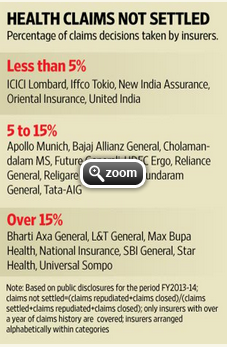Published in Mint on 11th January,2015 , Written by Kapil Mehta
Two years ago when Mint discussed rating individual health insurance products, I readily agreed. The idea was compelling. And how difficult could it be to put this together? Well, we underestimated the task. There are 26 insurers, offering about 50 health insurance products, over 300 product combinations and at least 10,000 information points to be considered. But if ever there was a task worth doing well, it’s this. Properly done ratings frame choices in a way that significantly improve your decisions. The Mint Mediclaim Ratings (MMR) is a guide to buying a good health insurance.
The MMR factors in three things that health insurance buyers must consider—price, product features and the insurer’s claims payment record. Of the three, collecting claims information is the most difficult and interpreting that properly is harder. Consider the two most commonsensical claims-related questions a buyer of health insurance would ask.
What proportion of claims has been paid for the product I want to buy? Why were the claims rejected? Today, however, these questions cannot be adequately answered with publicly available information. Published claims data combines individual and group insurance; cashless and reimbursement claims; government and non-government schemes. Product-wise claims are not segregated. Averages hide the true picture. For example, claim rejection is higher for individuals than for group insurances. So an insurer with high proportion of group will appear to have low claim rejection rates whereas their rejection on individual insurances, that you buy, may be high.

The published data is inconsistent. Most insurers publish quarterly information; and a few annual; in some cases the numbers don’t add up; an insurer states that no claims were repudiated last year which is not realistic; recent public disclosures are not available in one case; on some websites, pages do not load. We have sifted through this information, a summary of which is provided in the table.
In a similar vein, reasons for claim rejection are not published. A significant component of published data is “claims closed”. In some cases this is as high as 20% of claims decisions taken and refers to claims where complete information is not provided for an extended period of time. This is worrying. Why would so many people make a claim and then not follow through? There will be frauds but there are also many situations where claimants get worn out.
The solution to these issues is to publish a product-wise breakdown of claims settlement and reasons for rejection. It is a straightforward approach but likely to leave many insurers uncomfortable with the outcome.
There are two other aspects that we would like to factor in when reliable information is available. First, how effectively do complaints get addressed? And second, how comfortable is an insurer in issuing insurance to people with poor health?
According to published information for the financial year 2013, 98.64% of life insurance complaints and 98.47% of general insurance complaints were resolved. That’s unrealistically high. What does resolution mean? Was the complaint upheld? Partially upheld? Denied? The Financial Conduct Authority, UK publishes such information about complaints. It transparently says that only 53% of consumer complaints were investigated and 42% of these were upheld. We need similar transparency in our grievance data.
The insurer’s ability to issue insurance to most applicants is important. It is not useful to have the best-rated insurance if only Marvel Comics’ superheroes can clear the medical tests. For buyers, it is frustrating to go through an underwriting process and then not get insurance. We’ll factor “issuability” into the ratings when we are able to get this information.
Public ratings such as MMR nudge the industry forward. Over the past two years, there have been several new launches with customer-friendly features. Previously “C” rated products have started to move up the rankings and it’s getting harder for “A” rated products to retain their position. That’s excellent because as the health insurance industry presses forward, buyers benefit.
For the Mint Mediclaim Ratings tables, go to www.livemint.com/mintmediratings-
Insuropedia
Insurance
» Insuropedia » Media » Newspaper Columns » The difficulty in rating health insurance products
